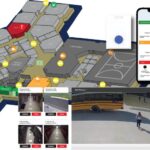Italian rehabilitation provider Reha Klinik is employing Bluetooth Low Energy (BLE) and Wi-Fi technologies as part of a solution that monitors dementia patients while providing asset tracking and voice connectivity at its new memory care facility in Bolzano. The system was deployed with the center’s 2020 opening to track the location and wellbeing of each patient, as well as provide wireless connectivity to detect high-value assets, and communication between healthcare providers and others.
The solution, provided by CWS Digital Solutions and utilizing technology from Cambium Networks, includes access points with built-in Wi-Fi and Bluetooth technologies, as well as Cambium’s cnMaestro software, which manages data on CWS’s server. The solution collects positioning data and processes it for staff use via a voice-over-IP (VoIP)-integrated service.
Reha Klinik is a new facility that was opened to house and provide healthcare for patients suffering from dementia. The five-story building includes 150 beds. Patients can move freely throughout the clinic, including in an outdoor secured area, and the company wanted their safety and location to be assured, even while giving them as much freedom of movement as possible.
To that end, the company sought a comprehensive patient-tracking system that would be capable of reporting and tracking patients’ movements while enabling them to make assistance requests. The facility wanted to be alerted if a patient entered an unauthorized area, as well as if someone fell, so that personnel onsite would know a patient needed help, as well as where that person was located. Reha Klink required a system that would provide VoIP services for healthcare providers and other employees.
Traditionally, such services are provided by multiple independent systems, but Reha Klinik sought a more unified approach. The clinic evaluated a variety of technologies from different providers before selecting a single Internet of Things (IoT) solution from CWS using Cambium sensors and software, according to Luca Passini, CWS Digital Solutions’ CEO. The clinic reports that its selection of this system was based on its simplicity and its ability to be integrated into the existing technology. The system offers scalability, Passini says, so it can be expanded over time as needed.
To develop a solution that met the clinic’s challenges, the technology providers had to equip the facility with a high-density Wi-Fi network offering thorough, site-wide coverage, according to Marco Olivieri, Cambium Networks’ regional sales director in Italy. Cambium worked with CWS and Reha Klinik to develop a system for locating patients and assets, implementing and connecting sensors that could send timely messages—such as alerts in the event of a fall—while ensuring wireless access for voice communication with doctors and nurses.
The Cambium access points provide a Wi-Fi network for communication with equipment, staff members, patients and visitors, while IP wireless phones are used in the clinic for internal and external communications with healthcare providers. All communications between employee apps and doctors take place through this VoIP service, managed by the Wi-Fi network.
The building has 150 beds and five floors, and the solution provides full coverage for the entire site. That amounts to 133 access points, as well as 15 more deployed around the campus outdoors. Cambium provides two products for this application, Olivieri says—its N° 133 cnPilot e600 Wi-Fi access points and N° 15 cnPilot e700 Wi-Fi access points—which comply with the 802.11ac Wave 2 standard. For location data, Wi-Fi can be used for assets (in which case the exact proximity is less critical) with the help of the system’s Wi-Fi spectrum analysis, while BLE proximity beacons provide more granular data for patients.
With the solution, each patient who lives at the clinic is provided with a bracelet that incorporates Cambium’s BLE tags that transmit to BLE units integrated in Cambium access points. A total of 100 such bracelets are in use. When a patient is registered in the system, that person’s identity is linked to the unique ID number encoded on the bracelet, with all identity information stored in the software. Each bracelet includes accelerometer sensors to detect a fall or long-term lack of movement, along with a push button so those wearing it can prompt an emergency call if they need help.
As patients go about their day, their wristband transmits a signal via BLE to the area access points. The data is captured and forwarded to CWS’s server, where Cambium Networks software identifies each individual specific to a particular floor and room. CWS also provides an application programming interface stack for integration with other systems that might be in use at the clinic.
Location granularity offered by the BLE system is less than 1 meter (3.3 feet), Passini says, and it is thus possible to accurately identify the patient’s room or general location, along with any “man down” alerts. Additionally, the software enables the clinic to set its own parameters. For instance, Reha Klinik needed to have a flexible system in place to monitor the positions of patients according to different details, such as the time of day, the date or a patient’s medical status. “So we have implemented a ‘rule-based system’ that can trigger alarms,” he adds, “when a single patient breaks one of the rules for the particular timeframe when the action happens.”
One of the primary rules, which is always on, is the “man down” warning. If a bracelet’s accelerometer detects a fall, the wristband will automatically transmit its ID and location, which will prompt an alert for staff members. The delivery method can be unique to a user, but in the case of Reha Klinik, the alert is dispatched as a message on the staff’s IP phone system. The software includes a dashboard on which a registered user can track patients in real time.
The monitoring of patients offered an unexpected benefit as the clinic navigated the COVID-19 pandemic, by providing positioning data that could be used in the event of a positive test for the virus. The system could display, upon request, all those who may have had contact with an infected individual. The Wi-Fi functionality is used to wirelessly manage the devices and appliances within the hospital. Assets such as laptop computers or other connected devices can transmit to the Wi-Fi system, thereby enabling the clinic to track their presence.
“The overall solution is a perfect symbiosis between the technological infrastructure provided by Cambium Networks and the dedicated software platform developed by CWS,” Olivieri states. All Cambium products are equipped with EN 60601-1-2 certification as well, to be leveraged in and around medical environments, “guaranteeing a very low electromagnetic impact toward the other equipment and natively integrating BLE technology.”
According to Passini, Reha Klinik is currently evaluating whether or not it will use this technology to gather data from additional sensors inside a patient’s bracelet that can be collected and monitored. This data includes a person’s blood pressure, temperature and heart rate. In the future, he says, the system is expected to be deployed for the clinic’s existing structure, known as Villa Melitta.
This article originally appeared in CS sister publication RFID Journal and has been edited. Claire Swedberg is RFID’s senior editor.













